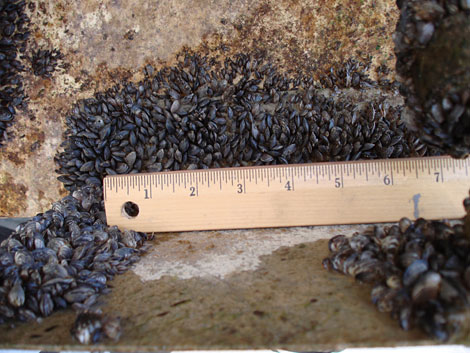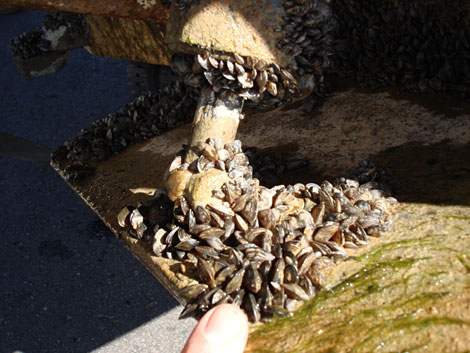

 Quagga Mussels attached to a Reclamation boat. (Reclamation photograph)
Quagga Mussels attached to a Reclamation boat. (Reclamation photograph)The quagga mussel (Dreissena rostriformis bugensis) is a freshwater mollusk that is native to Eastern Europe. This thumbnail-sized animal (and a similar one called the zebra mussel) arrived in the United States in the 1980s. It began to spread throughout many eastern waterways, rivers, and lakes.
In 2007 the invasive quagga mussel was discovered in Lake Mead, Lake Mojave and Lake Havasu on the Colorado River. The discovery generated instant concern, as these mussels can colonize water supply systems at hydroelectric power plants and similar facilities to the point of disrupting operations.
Quagga mussels spread in numerous ways, mainly by floating in the currents of the water body or by "hitching" a ride on a boat or other water vessels in infested water and then transported to another water body. They attach to hard surfaces and are known to clog intakes and engines, pipes, and water transport structures. In addition, they are known to appear in any water that is in the bilge or ballast tank.
 Quagga Mussels attached to a Reclamation boat. (Reclamation photograph)
Quagga Mussels attached to a Reclamation boat. (Reclamation photograph)Knowledge and experience in the Eastern U.S. indicates that once introduced, the mussels are almost impossible to eradicate in water bodies and facilities comparable to Reclamation facilities.
The Bureau of Reclamation's Lower Colorado Region immediately embarked on a concerted effort to learn more about these mussels. The objectives were twofold: to ensure the mussels did not affect power generation or water delivery operations at Hoover, Davis and Parker dams, and to gather information that could be shared with other water facility owners and operators about the mussel, its potential impacts, and methods of preventing or combating those impacts.
Throughout 2007, Reclamation, inspected facilities, conducted research, established partnerships with other water utilities in the Lower Colorado River Basin, conducted a sampling program to determine the density of mussel larvae in Lake Mead and Lake Mohave, and supported public outreach efforts.
The presence of Quagga and Zebra mussels in the western United States waters is the top priority for Reclamation's Science and Technology Program. The program is directing research and development to detect and control invasive mussels throughout all of Arizona's water facilities. Reclamation's Zebra and Quagga Mussel Research Program includes coordinated research activities to demonstrate effective monitoring and control solutions that can be applied across Reclamation. Success will involve close coordination and cooperation between Reclamation project managers and researchers, private industry, managing partners, and other federal, state, and local agencies.
It may not be possible to eradicate the mussel from the Colorado River system, but, working in partnership with others, the Lower Colorado Region is taking steps necessary to ensure Reclamation hydroelectric facilities continue to provide water and power for the American Southwest.
In addition, boater and other recreational watercraft users should take simple, precautionary steps - every time they go to a lake, river, or stream.
- Drain the water from the boat, live well and the lower unit of the engine.
- Clean the hull of your boat.
- Dry the boat, fishing gear, and equipment.
- Inspect all exposed surfaces.
- Remove all plant and animal material.
More Information:
http://www.usbr.gov/mussels/history/factsheets/general.html
http://www.usbr.gov/lc/region/programs/quagga/history.html
